Old Galway
EAMONN DEACY PARK

by Tom Kenny
The townland in which this park is situated is known as Terryland or Tirellan, derived from the Irish Tír Oileáin (The Land of the Islands) which was so named because the river divided into many streams thus creating islands in the area. It is in the Civic parish of St. Nicholas in the Barony of Galway.
Historically, the area was famous for Terryland Castle, popularly known as Oldcastle, a strategically important building as it commanded the river at a point where there was a ford. The De Burgh family built the castle in the late 14th or early 15th century to protect the river crossing from the O’Flahertys. It later devolved to the Lynch family. It was occupied by Sir Charles Coote during the Cromwellian campaign. In 1691, there were French Musketeers in residence when it was being attacked by General Ginkel. They abandoned it and set fire to it leaving it in ruins ever since.
THE END OF THE OLD CLADDAGH
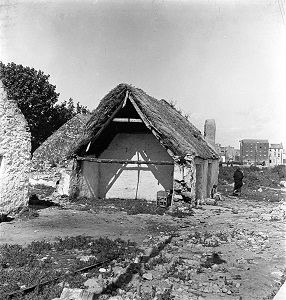
by Tom Kenny
In 1812, there were 468 cabins or houses, all thatched, in the Claddagh. These were occupied by 500 families totalling 1,050 males and 1,286 females. That was a lot of people and houses in a relatively small geographical area and could be described as a “Clachan”, a large irregular group of houses clustered closely together. All of these houses were single storey buildings, only the two-storeyed “Aran View House” and the early 19th century coastguard houses were higher.
PART OF FORSTER STREET, 1905
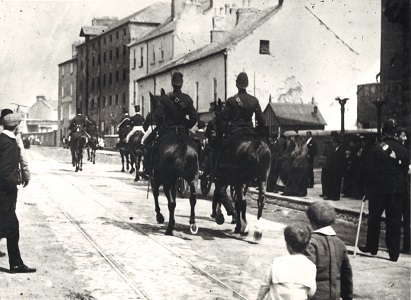
by Tom Kenny
This photograph, taken from an old glass slide, shows some important personage in an escorted carriage leaving the Great Southern Hotel. There are some mounted liveried gentlemen in front and two RIC men on horseback behind the carriage, which is hidden by the RIC men. You can see a policeman on foot to the right of our picture.
The tramlines in the foreground lead to the terminus which was in Forster Street which was named after the Blake-Forsters, an eminent family, several of whom were mayors of Galway. The street was known as Boherbeg (as opposed to Bohermore). It appears on an 1820 Eyre document as ‘The Mail Coach Road’. The small black hut you see on the right was a toll booth, known locally as ‘the custom box’. It was the busiest toll booth in Galway and in the twelve months leading up to May 15th, 1913, the authorities collected £654 – 10 -2 here. They paid out wages of £56-5-6 in that time so the profit to the city was £598-4-8, a lot of money in those times.
SEAMOUNT NURSING HOME
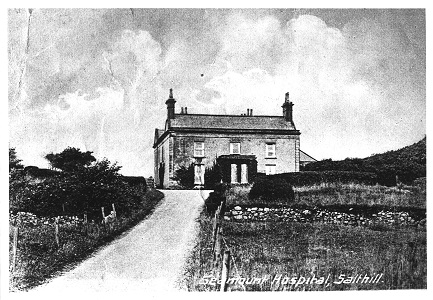
by Tom Kenny
A “To Let” advertisement in a Galway newspaper in April 1860 promoted the fact that Seamount Villa contained a parlour, drawing room, six bedrooms, a kitchen, water closet, a coach house with some stabling and a small garden. The grounds were nicely laid out and had an approach to the sea. George Fallon who lived at ‘The Baths’, Salthill would show the place to prospective customers.
In 1895, the building, which was situated near Blackrock at the end of the promenade, was occupied by Sebastian Nolan who at one time lived at Ballinderry Castle near Tuam. He was an eccentric and cranky man who fell in love with an East Galway girl who shunned him and joined the Mercy Nuns. When he died in 1907, he left some money and property, including Seamount Lodge, to the Mercy Nuns. It was part of Nolan’s will that the produce from his vegetable garden would go to the Magdalen House in Forster Street. Because of some legal difficulties, the nuns were unable to occupy Seamount for some time.
FRANCIS CORBETT IN HIS STUDIO
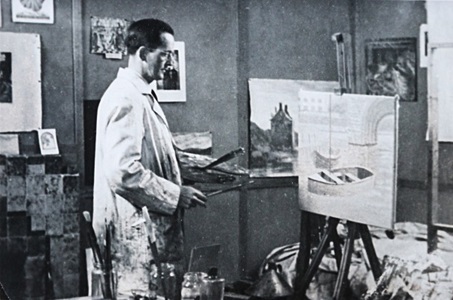
by Tom Kenny
Francis Corbett was a member of the well known business family who owned Corbett and Sons in Williamsgate Street. He was one of five siblings, one of whom, Gerard, went into the business. Francis also worked there but only for a relatively short time, as he died relatively young in 1946. He was a talented artist, as were his brother Redmond and his sisters Lucy and Agnes. Francis was one of the founders of the Galway Art Club, and became its first treasurer.
FR. LALLY’S, STREET LEAGUE UNDER 14 CHAMPIONS, 1965
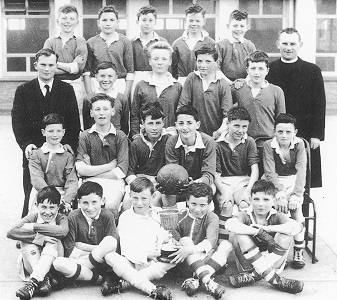
by Tom Kenny
In 1881, Father Lally was made parish priest of Rahoon. At the time the parish was served by two churches, Bushypark and Barna, Dr. McEvilly, Bishop of Galway was appointed as Archbishop of Tuam and Father Lally was made Vicar Capitular of the Diocese in the interregnum until the appointment of a successor to Dr, McEvilly. McEvilly was aware that the very large parish of Rahoon had no central church so he gave Fr. Lally money to start the process of erecting a new church beside the Presentation Convent. Fr. Lally collected the funds and employed direct labour to build the church. The foundation stone of St. Joseph’s was laid on April 22nd, 1882 and the church was consecrated on February 7th, 1886.
WILL GALWAY BEAT MAYO?
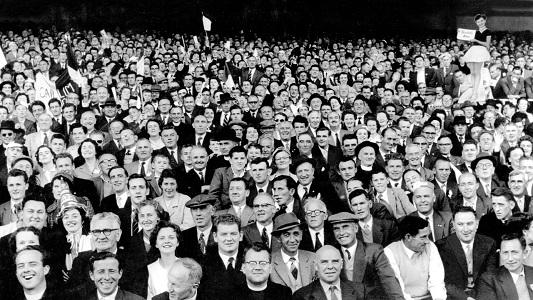
by Tom Kenny
The rivalry between Galway and Mayo is as old as the provincial championship itself. The Connacht GAA Council was actually founded on the same day that Galway and Mayo contested the first ‘official’ Connacht senior football final. That game was played in Claremorris in November 1902 and was won by Mayo. Galway played “with the wind and the incline” in the first half while the vast crowd agreed to ‘keep strictly outside the field of play’, something the organisers clearly regarded as an unexpected bonus.
Liam Mellows, county champions
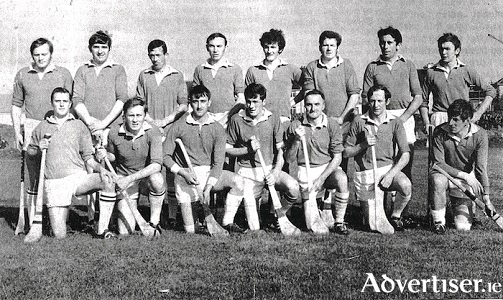
by Tom Kenny
We know that hurling was played in the Bohermore area 200 years ago. Several different clubs operated around there at different times — Galway City, Bohermore 98s, College Road, Thomas Ashe, etc. Players would occasionally transfer from one club to another so it was natural for them to join the new club that was formed on February 11, 1933. The club was called Liam Mellows after the patriot who led the 1916 rebellion in Galway.
.png)